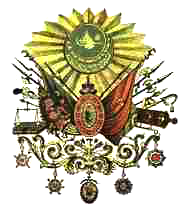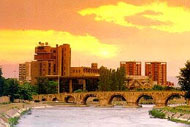The HAYRETTIN`s an oldest turkish family in SKOPJE
USKUP-(Todays Skopje)
USKUB, USCUP, or SKOPIA (anc. Scupi, Turk. Ushkiib. Slav. Skoplye), the capital of the vilayet of Kossovo, European Turkey; on the left bank of the river Vardar, and at the junction of the railways from Nish and Mitrovitza to Salonica. Pop. (1905) about 32,000, consisting chiefly of Slavs (Serbs and Bulgars), Turks, Albanians and a few gipsies. Uskiib occupies a picturesque and strategically important position at the foot of a valley which severs two mountain ranges, the Shar Planina and Kara Dagh. Main roads radiate N.W. to Prizren, W. to ostivar, an important centre of distribution, E.N.E. to Kuma-novo, and thence into Bulgaria, and S. to Koprulii and Monastir. The city is the headquarters of an army corps, and the see of an Orthodox Greek archbishop, of the archbishop of the Roman Catholic Albanians and of a Bulgarian bishop. Its principal suildings are the citadel, the palace of the vali or provincial governor, the Greek and Bulgarian schools, numerous churches and mosques and a Roman aqueduct. The industries include dyeing, weaving, tanning and the manufacture of metal-work, wine and flour, but Uskiib is chiefly important as the commercial centre of the whole vilayet of Kossovo (_q.ii.). The Imperial Ottoman Bank and the Banque de Salonique have branches in the city, and French is to a remarkable extent the language of commerce. Uskiib retains in a modified form the name of Scupi, one of the chief cities of northern Macedonia. A few unimportant ruins mark the ancient site, about if m. N.W. Scupi was destroyed by an earthquake in A.D. 518, but was rebuilt by Justinian under the name of Justiniana Prima. Up to the i4th century it was at times the capital of the Servian tsars.
The Ottoman city
The Ottoman city
In 1392, three years after the Serbian defeat in the Battle of Kosovo in 1389, Skopje was captured by the Ottoman Empire. For the next five hundred years it was known by the Turkish name was the capital of the Vilayet of Kosova (district of Kosova), which occupied a much greater area than the modern Kosovo.
The city's character changed markedly during this period. The Ottomans imported Islam and built many mosques and other typically Turkish buildings, such as hammans (baths) and travellers' inns, some of which still exist today. Many Sephardi Jews expelled from Spain also settled in the city, adding to its ethnic variety.
The medieval city was badly damaged by an earthquake which struck in 1555, but it soon recovered and prospered. By the 17th century, its population was put at between 30,000-60,000 inhabitants. The Turkish writer Dulgar Dede visited during this period and wrote: "I travelled for many years across that country of Rumelia and I saw a many beautiful cities and I was amazed at Allah's blessings, but not one impressed and delighted as much as the heavenly city of Skopje across which passes the Vardar River."
In 1689, however, Skopje was burned by the Austrian general Engelberto d'Ugo Piccolomini ostensibly to eradicate an outbreak of cholera, but quite possibly to revenge the Ottomans' 1683 attack on Vienna.
The city's fortunes waned over the next 200 years and its population shrank to only about 10,000 people by the middle of the 19th century. It revived after 1873 with the building of the railway from Belgrade to Thessaloniki, which passed through Skopje.

Ottoman Coat of Arms
Sign were can usually be seen over old buildings dated from the Ottoman Empire era.
Skopje (Macedonian: Serbo-Croatian: Skoplje, Albanian: Shkup, Ottoman Turkish: Uskup, Ancient: Scupi (see History), see also different names) is the capital city of the Republic of Macedonia. It has 506,926 inhabitants (2002 estimate) and is located on the upper Vardar river.
Skopje is the political, economic, and cultural centre of the modern Republic of Macedonia. It is a major centre for the metal-processing, chemical, timber, textile, leather, and printing industries. Industrial development of the city has been accompanied by an intensive development of the trade and banking sectors, as well as an emphasis on the fields of culture and sport.
Buildings
North of the city there is a Roman aqueduct. Medieval monasteries in the vicinity include that of Nerezi (1164), with rather realistic 12th-century frescoes, similar to the Giotto’s pictures, some 140 years latter. There are notable buildings from the Turkish rule such as the KursumliHan (medieval Turkish inn) and several mosques.
In the 20th century
In the 20th century
Earlier failed attempts to obtain separate church in the 1890s resulted Macedonian Slavs to continue being counted as Bulgarians or Serbs, depending of their church affiliation and national consciousness. By 1905, Skopje had a population of approximately 32,000, which was comprised of a mixture of ethnic groups, including Albanians, Bulgarians, Roma, Serbs and Turks. The city was the seat of an Greek Orthodox archbishop, an archbishop of the Roman Catholic faith, and a Bulgarian Orthodox bishop. In 1910, the Albanian nun, Agnes Gonxha Bojaxhiu, later to become famous as Mother Teresa, was born in Skopje.
The city became a major centre of rebellion against the weakening Ottoman Empire, and in 1903 it was a key player in the unsuccessful Ilinden Rising against Ottoman rule. In 1913, the allies in the First Balkan War fell out with each other and launched the Second Balkan War over the division of the spoils. Serbia retained control of Skopje, with the Vardar valley being incorporated into Serbia. This lasted until October 1915, when Bulgaria joined the Central Powers and seized much of Serbian-ruled Macedonia.
The city was restored to Serbia at end of the World War I in 1918, when it became part of the Kingdom of the Serbs, Croats and Slovenes (known as the Kingdom of Yugoslavia from 1929). The city was occupied by Bulgaria rule during both World Wars, but on its liberation in 1944 it became the capital of the new People's Republic of Macedonia. Following the wars, Skopje and the rest of Yugoslav Macedonia was incorporated into Tito's Socialist Federal Republic of Yugoslavia.
On 26 July 1963, Skopje was struck by another major earthquake, which killed over 1,000 people and made another 120,000 homeless. Eighty percent of the city was destroyed by the earthquake, and numerous cultural monuments were seriously damaged. A major international relief effort saw the city rebuilt quickly, though much of its old Turkish aspect was lost in the process. The ruins of the old Skopje train station which was destroyed in the earthquake remains today as a memorial to the victims. The memorial features a museum.
Under Yugoslav rule Skopje grew rapidly and became a major industrial centre for the southern Balkans region. In 1991 the Yugoslav federation broke up and Skopje became the capital of the independent Republic of Macedonia. Greece objected to the use of the name Macedonia by the new state, and imposed an economic blockade on the country, which severely damaged Skopje's economy by closing its access to the sea through Thessaloniki. The blockade was lifted in 1995 following an agreement between Athens and Skopje.
